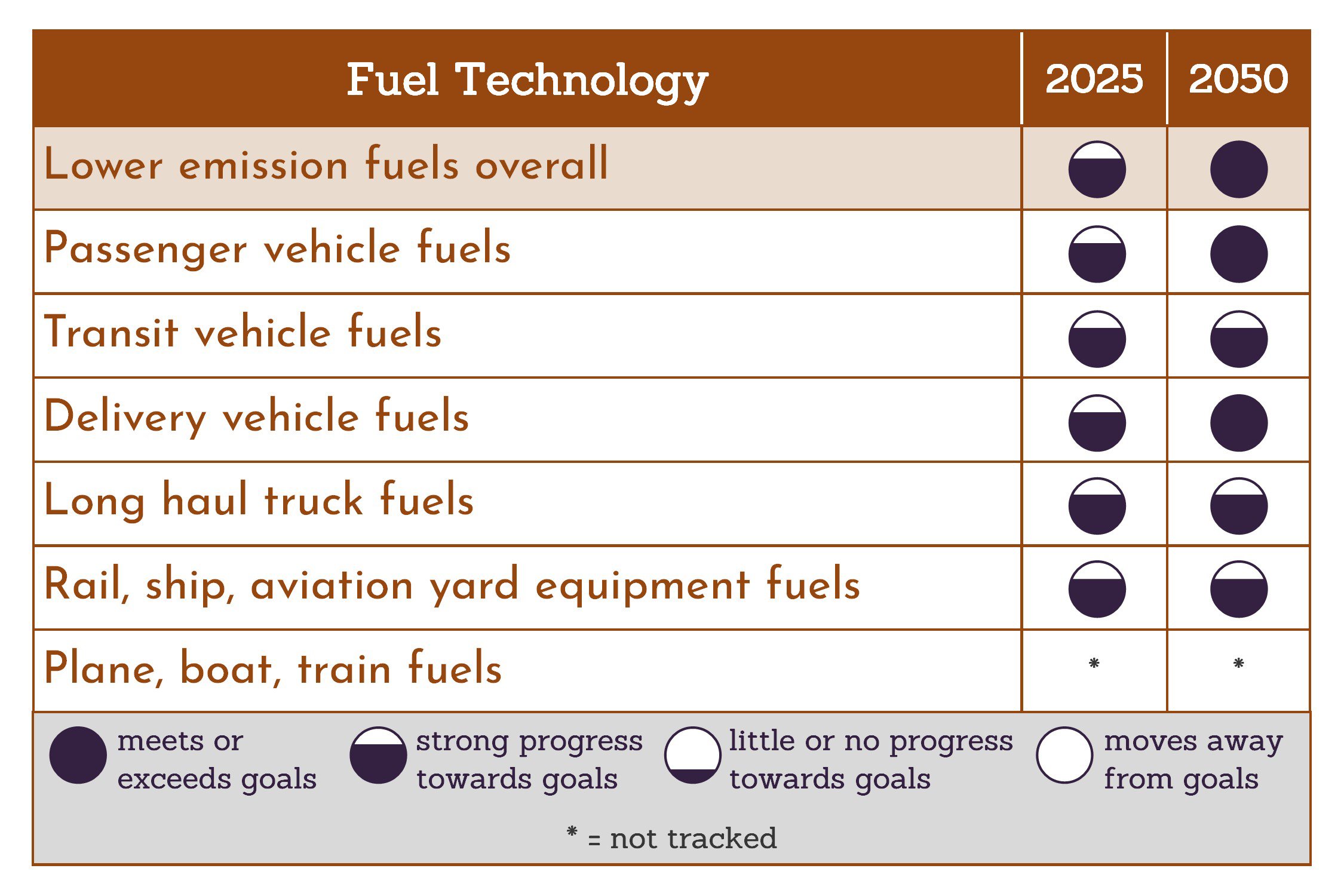Lower Emission Fuels
Lower emission fuels have a lower carbon intensity than gasoline or diesel. A lower carbon intensity means they produce lower emissions to move a similar vehicle the same distance.
While not all electricity has a lower carbon intensity, electric vehicles are more than three times as efficient as gasoline and diesel vehicles, so the resulting emissions are much lower. (See the Vehicle Technology and Cleaner Electricity Grid pages to learn more.)
Lower emission fuels: emissions reduction vision
By 2050, achieve a 20% reduction in lifecycle carbon intensity of non-electric fuels used by passenger, transit and delivery vehicles from 1990 levels.
By 2050, achieve a 30% reduction in lifecycle carbon intensity of non-electric fuels used by long-haul freight trucks, trains, and ships, relative to 1990 levels.
Build public fueling stations for lower emissions fuels along Oregon’s designated alternative fuel corridors and other major routes across the state.
How Oregon is doing
The average carbon intensity of Oregon’s fuels has been steadily decreasing. The decrease is due to the Clean Fuels program, run by the Oregon Department of Environmental Quality. The program regulates the transition to lower carbon (and therefore lower emission) fuels.
In 2022 DEQ updated the Clean Fuels program, extending its role in driving down fuel emissions another 10 years. This provides incentives to shift to lower emission fuels, especially in transit, heavy trucks and off-road freight vehicles. The new regulations are expected to achieve the lower emission fuels vision by 2035 rather than 2050. This is good news because not all vehicles have ways to electrify yet; the Clean Fuels Program helps Oregon lower emissions while we wait for options to become more available and affordable.
Oregon is also a national leader in “blend fuels” that use fossil fuels mixed with lower emission fuels. The resulting blended fuels emit less greenhouse gas emissions.
Cars, trucks, SUVs and smaller delivery vehicles
These vehicles use gasoline with at least 10% ethanol blend, per state standard.
A 15% blend is the limit for gasoline-ethanol fuels without expensive changes to vehicle engines. Long term, the plan is wide-scale electrification of these vehicles.
Larger delivery vehicles and long haul trucks
These vehicles use diesel blended with at least 5% biodiesel or renewable diesel, per state standard.
Biodiesel is plentiful throughout the U.S., but renewable diesel is in short supply and demand is high. Production will continue to increase in the next few years as multiple private projects under construction are completed.
Other low-emission diesel replacement fuels exist, like renewable versions of natural gas and propane, but they require specialized engines.
Long term, the plan is wide-scale electrification and possibly clean hydrogen for larger vehicles. Until these vehicles are more broadly available, we’ll rely on lower emission fuels to reduce emissions.
Boats, trains, and off-road vehicles and equipment
These vehicles face the same hurdles as their on-road gas and diesel counterparts. While some off-road equipment can electrify now, lower emission fuels will be key to reducing emissions until new vehicle options are available.
Sustainable aviation fuel does exist but is extremely limited. The Port of Portland has plans to start using up to 10% sustainable aviation fuels by 2030.
How Oregon can improve
The shift to lower emission fuels needs to happen quickly while electric vehicle and other low emission technologies become more affordable and mainstream. Oregon will need a mix of investments from the public and private sectors to build out fuel availability and infrastructure; there is no “one size fits all” solution, especially with commercial vehicles.
State government agencies are working to accelerate the shift to lower emission fuels by leveraging the updated Clean Fuels regulations and new federal funding. Additionally:
The Oregon Department of Transportation can help transit operators make the transition to lower emission fuels and vehicles through fleet asset planning, funding, and compliance under state and federal programs.
State agencies can incentivize more production of lower emissions fuels by leading with bulk use in public fleets.
In 2022 ODOT studied how Oregon can prepare for hydrogen fuel technology over the next 15 years. An Oregon Department of Energy report also examined opportunities and barriers to bringing cleaner hydrogen to Oregon.
ODOT can designate more of Oregon’s highways and interstates as Alternative Fuel Corridors, which allows them to receive more resources to expand infrastructure for lower emission fuels.
ODOT and local road managers can follow recommendations to reduce greenhouse gas emissions from road construction and maintenance in ODOT’s report on agency operational greenhouse gas emissions and a recent DEQ report on non-road vehicle emissions.
For marine, airports and rail modes, public agencies can continue to support pilot programs, infrastructure funding, and regulatory incentives to shift to lower emission fuels.
In general, ODOT’s work will focus on infrastructure for electric vehicles, and fuel cell vehicles that use hydrogen. The Oregon Department of Environmental Quality will implement the Clean Fuels Program, which will increase the availability of lower emission fuels and lower their prices.

